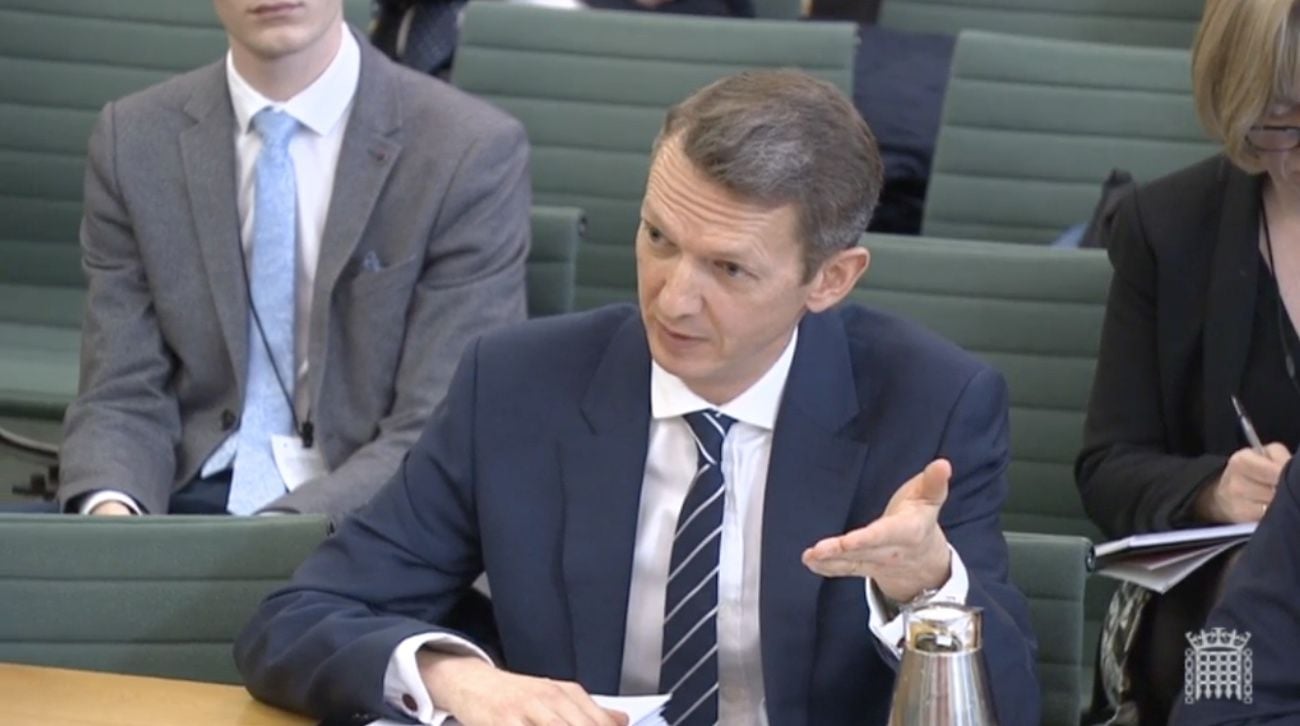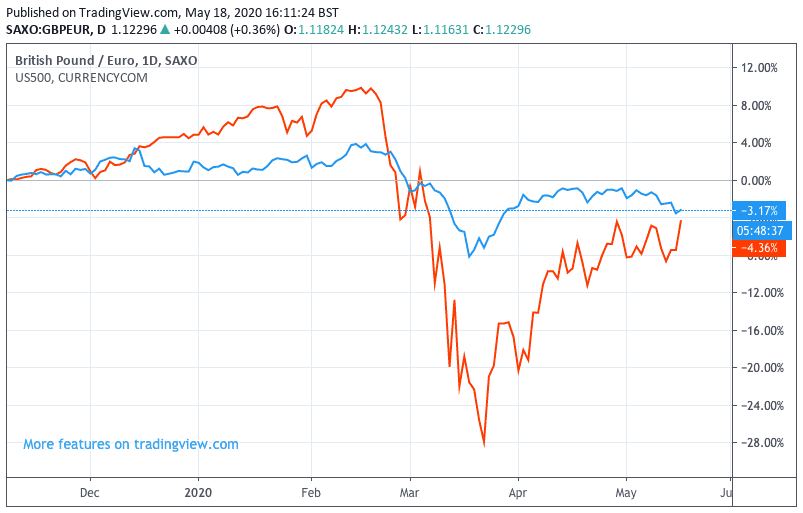Haldane Signals Prospect of Negative Interest Rates at Bank of England, Move to Cap Sterling Upside
- GBP aided by improving markets at start of new week
- Bank of England looks to be considering cutting rates yet further
- Brexit trade negotiation anxieties continue to build

Above: File image of Andy Haldane. © UK Parliament, Pound Sterling Live

- Bank transfer rates (indicative): 1.0935-1.1014
- FX specialist rates (indicative): 1.1100-1.1127 >> More information
- Bank transfer rates (indicative): 1.1870-1.1960
- FX specialist rates (indicative): 1.2000-1.2090 >> More information
The British Pound rose by over a percent against the U.S Dollar at one stage on Monday, May 18 while the currency's broad-based strength meant it also recording a half-percent advance against the Euro.
The gains came amidst a broad-based improvement in investor risk sentiment that swept global stock markets, commodities and risk-on currencies higher.
Sterling has over recent weeks shown itself to be a 'risk on' currency, proving highly responsive to broader investment appetite: rising when markets are rising and falling when they are in decline.
Markets had stagnated for much of May, a scenario that allowed issues concerning Brexit trade negotiations and Bank of England policy expectations to take a hold of Sterling and exert downside pressures.
The bounce in global stock markets at the start of the new week has however mitigated some of these negative forces and allowed the UK currency to experience a rebound.
"The impending easing of lockdown measures throughout the U.S. and Europe continues to provide both a source of both optimism and anxiety given the potential implications if they are successful or not. However, Jerome Powell has reminded us that markets are likely to remain well supported irrespective of the outcome of the impending lockdown easing policies, with both Powell and Lagarde continuing to provide a ‘whatever it takes’ approach to dealing within this crisis," says Joshua Mahony, Senior Market Analyst at IG.
The above graphic shows the GBP/EUR exchange rate (blue line) and the S&P 500 (orange line) which we consider to be a reflection of broader investor appetite. We see there does tend to be correlation between moves in Sterling and broader investor appetite.
However, Sterling strength might well have its limits as the currency started the new week by printing fresh multi-week lows against the Euro, Dollar and other major currencies following comments from a senior Bank of England policy maker that negative interest rates in the UK are a possibility in the future.
Andy Haldane, the Bank of England’s chief economist, said ahead of the opening of FX markets that yet further easing measures - including negative interest rates - could be introduced to alleviate the economic slump caused by the coronavirus pandemic.
"GBP is underperforming slightly after BoE Chief Economist Haldane said the BoE was considering a range of further easing options, including negative interest rates," says Adam Cole, Chief Currency Strategist at RBC Capital Markets.
The comments by Haldane come just days after the Bank's Deputy Governor for Monetary Policy, Ben Broadbent, discussed the matter, suggesting cutting interest rates below zero might be gaining traction within the Bank's Monetary Policy Committee. Haldane said negative interest rates were not an ideal outcome, but crucially, he failed to rule them out, triggering a decline in the value of the Pound as a result.
Falling interest rates matter for Sterling as the return offered by UK financial assets has historically drawn in significant flows of foreign capital. The lower interest rates at the Bank of England fall, the less attractive these assets become to foreign investors, which in turn weighs on demand for Sterling.
The Pound-to-Euro exchange rate is quoted at 1.1180 at the start of the new week, its lowest level since March 30, the Pound-to-Dollar exchange rate is quoted at 1.2097, its lowest level since March 26.
Haldane said pushing interest rates below zero, as well as buying riskier assets under the central bank’s bond-purchase programme, could not be ruled out.
"The economy is weaker than a year ago... so in that sense it’s something we’ll need to look at, are looking at, with somewhat greater immediacy," said Haldane. "How could we not be?"
The Bank has already cut its basic lending rate to 0.1%, a record low, since the outbreak of the coronacrisis and economists and other Bank of England policy makers will question the benefit of cutting interest rates yet further, noting that the benefits to the economy tend to decrease in scale the lower interest rates are cut.
It is widely believed 0.1% represents a 'lower bound' level, beyond which there is little benefit of cutting rates further. However, other central banks such as the European Central Bank and Bank of Japan have cut interest rates into negative territory in order to try and stimulate inflation, creating a precedent that only makes it easier for the Bank of England to follow.
In addition to cutting interest rates in response to the crisis, the Bank of England has announced a £200bn injection of capital into the market via its quantitative easing programme, as well as cutting bank buffers to free up lending capacity and introducing a scheme to support small business lending.
The Bank opted to keep interest rates and quantitative easing levels unchanged at their May 07 meeting, but they said they stand ready to act further and introduce more easing measures, if necessary.
The potential for further action at the Bank in the coming months is therefore elevated and with the UK's quantitative easing programme being one of the largest in the world relative to GDP, we would expect Sterling to remain under pressure as a result.
Haldane said that the Bank of England could consider purchasing a greater range of assets under an expanded quanitatitve easing programme. "He spoke about the possibility of going lower down the ratings ladder when purchasing corporate bonds, as other countries have done, but also at the possibility of negative interest rates. The talk of the bank charging money on deposits was enough to send Sterling down to lows that we haven’t seen since late March," says Mark Palmer, an analyst at Hamilton Court FX.
The Bank of England is only one of three major drivers for Sterling at present, the other two drivers being the market's broader response to the global coronacrisis and the issue of Brexit trade negotiations.
Sterling slumped ahead of the weekend following growing signs the EU and UK are at a deadlock in trade negotiations.
Following the latest round of talks which concluded on Friday, the UK's chief negotiator David Frost said the EU were making "novel and unbalanced proposals on the so-called level playing field," adding that the list of demands were without precedent in previous EU trade deals.
The Pound-to-Euro exchange rate fell by over a percent to its lowest level since April 01 at 1.1245 on the developments, as markets raised expectations that negotiators would not reach agreement ahead of a crucial June 30 deadline.
The Pound-to-Dollar exchange rate dipped 0.80% to reach its lowest level since March 27 at 1.2133.
"Make that a seven-week low for Sterling. Growing doubts over the U.K. and EU reaching a trade deal in the months ahead gnawed anew at the pound. Mostly risk off global markets and the Bank of England not ruling out negative borrowing rates added traction to the pound’s turn to the bottom of its range," says Joe Manimbo, a foreign exchange analyst at Western Union.
Frost thanked his EU counterpart Michel Barnier and their respective teams for the determination shown to work through differences, despite the difficult circumstances posed by the coronavirus crisis.
"I regret however that we made very little progress towards agreement on the most difficult outstanding issues between us," said Frost.
There remains just one further round of negotiations before a June 30 deadline by which the UK must request an extension to the negotiating period, or the EU and UK risk defaulting to a WTO trading relationship at the turn of the year.
Foreign exchange analysts say this outcome would be negative for Sterling as the UK would lose direct access to the single EU market and the country will be deemed to be a less desirable destination for foreign investors.
The EU and UK are due to decide by the end of June whether the current deadline for negotiating an agreement should be extended beyond the end of December.
The UK has said it will not agree to an extension, even if the EU requests one, raising the prospect that the two sides will default to trading rules prescribed by the World Trade Organization at the start of 2021 which is likely to significantly hamper trade.
While both sides are yet to make any progress the market will be aware that there remains a further round of negotiations in June, and even beyond here top-level talks between Prime Minister Johnson and EU leaders can achieve progress ahead of the June 30 deadline.
The Times reports on Monday the European Union is ready to back down from its hard line on fishing rights next month once Europe’s leaders get involved in post-Brexit trade negotiations, according to senior sources in Brussels.
Michel Barnier, the EU’s chief negotiator, has struggled to gain “attention” from European capitals during the coronavirus crisis on the need to shift from what he has conceded is a “maximalist” mandate on fisheries demanded by France, Spain, Belgium and the Netherlands.
It must also be noted that this deadline is by no means written into law and is therefore not as 'hard' as previous deadlines seen in the Brexit process, meaning it by no means signals a WTO trade deal as being inevitable.
As such, Sterling might be safe from any major Brexit-related sell-offs for many months yet, but don't expect any major recovery while this topic remains alive.

